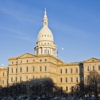New American Economy Releases the NAE Cities Index, a First-Ever Analysis Measuring How Effectively Cities are Integrating Immigrants
Date: September 17, 2018
NEW YORK, NY – Today, on Citizenship Day, hundreds of civic and business leaders, including Members of Congress, mayors, city council members, and chamber of commerce executives, joined New American Economy to release the NAE Cities Index—the first comprehensive, national assessment of immigrant integration policy and socioeconomic outcomes in the largest 100 U.S. cities. What impact immigrants are having on communities, and how well they are integrating, are two questions at the center of the national immigration debate. The NAE Cities Index provides the first comprehensive way to assess these questions and understand how immigrants and their destination communities are faring.
The cities with the highest scores in the NAE Cities Index tend to fall into three different profiles:
-
Cities that are starting to rebound after years of job and population loss that resulted in economic instability, like Newark, NJ, and Baltimore, MD, where immigrants are bringing the much-needed skills and entrepreneurial spirit that can help develop a more stable and educated workforce, encourage new business creation, fill vacant housing, and expand local tax bases. In these cities, the gap between immigrants and the U.S.-born is much smaller than in the rest of the country when it comes to indicators such as poverty rates, educational attainment, and entrepreneurship rates.
-
Cities that are immigrant hubs, like New York, NY, and San Francisco, CA, that have succeeded in creating a welcoming environment with strong policies focused on inclusivity and providing access to city services and information. Inclusive policies help make these cities destinations for the creative class and for high-skilled businesses. However, some of these cities do not score as highly on socioeconomic measures such as access to housing or income equality.
-
Cities that are new immigrant gateways, like Atlanta, GA, and Greensboro, NC, which are some of the fastest growing places in the country. In these cities, immigrants and U.S.-born newcomers together are helping to create the diverse workforce necessary to continue growing and attracting new businesses. These cities scored highly on socioeconomic indicators such as job opportunities at all skill levels, affordable and quality housing, and educational opportunities.
Explore the NAE Cities Index to see how your city is doing.
The NAE Cities Index scores each city based on 51 unique measures, including policies like language access and support for immigrant entrepreneurs, as well as socioeconomic outcomes like labor force participation and homeownership rates. Overall scores range from 1-5 (5 highest), and offer insight into how well cities are integrating newcomers. 2018 is the first year for the NAE Cities Index, which will be updated annually to track cities’ progress. Learn more about our methodology.
Key Findings:
-
Large, traditional immigrant gateways top the policy category in the Index. San Francisco, CA; Los Angeles, CA; New York, NY; Chicago, IL; and Seattle, WA, take the top five policy spots as a result of their strong support for immigrants. Each city earned perfect scores in Government Leadership and Legal Support, and all maintain a local office dedicated to immigrant integration (e.g., Office of Immigrant Affairs).
-
Smaller, more affordable cities top the socioeconomic outcomes category in the Index. St. Petersburg, FL; Baton Rouge, LA; Newark, NJ; Chula Vista, CA; and Henderson, NV;—each among the smallest third of the Index cities in terms of population—took the top five socioeconomic outcome spots. These cities scored especially high in Livability, pointing to smaller gaps in homeownership rates, health insurance rates, and educational attainment rates between immigrants and the U.S.-born.
-
The top 25 cities in the Index are attracting larger shares of highly skilled immigrant and U.S.-born residents, making them more competitive for business and economic investment. In the top 25 cities, on average, the share of immigrant advanced degree holders (15.9%) and U.S.-born advanced degree holders (14.5%) is higher than in cities in the Index overall (12.8% and 12.9%, respectively).
-
The top 25 cities in the Index are better for both immigrant and U.S.-born entrepreneurs, making them more likely to see job creation. On average, U.S.-born entrepreneurs living in the top 25 cities earn more than $1,000 more per year than U.S.-born entrepreneurs in Index Cities overall, and foreign-born entrepreneurs in the top 25 cities earn more than $100 more per year than foreign-born entrepreneurs in the Index Cities overall. Additionally, U.S.-born individuals living in the top 25 cities, on average, also have slightly higher rates of entrepreneurship (8.1%) than their U.S.-born counterparts (7.9%) in cities overall.
-
The top 25 cities also benefit from greater equity between immigrants and the U.S.-born across key measures of quality of life. Across homeownership rates, health insurance rates, and poverty rates, there are smaller gaps between the U.S.-born and immigrants in the top 25 cities than in cities overall. U.S.-born and immigrant residents of the top 25 cities also have higher overall health insurance rates (90.1% and 75.8%, respectively) compared with their counterparts in cities overall (89.0% and 70.2%, respectively).
-
Among top-ranked cities, attracting immigrants is key to population growth. Both Newark, NJ, and Baltimore, MD, which top the 2018 Index, would have seen their populations shrink since 2010 but for the immigrants who came, stabilized their brain drain, and allowed both cities to grow. Similarly, 18 of the top 20 cities in the Index experienced population growth between 2010 and 2017.
-
There are regional trends in how welcoming and inclusive cities are of immigrants. The Northeast (CT, ME, MA, NH, NJ, NY, PA, RI, VT) and the Pacific (AL, CA, HI, OR, WA) have the highest overall scores and the most welcoming policies. Meanwhile, the South Central (AR, LA, OK, TX) region has the lowest overall scores and the least welcoming policies.
“The evidence is clear – cities that level the playing field for immigrants produce benefits for all their residents, the U.S.-born and immigrants alike,” said John Feinblatt, President of New American Economy. “Cities that top the NAE Cities Index are attracting newcomers, expanding their talent pools, and creating greater returns for entrepreneurs every day.”
“On Citizenship Day, we’re proud to recognize the thousands of immigrants who have chosen to make Philadelphia their home,” said Mayor of Philadelphia Jim Kenney. “The results of the NAE Cities Index show that these new citizens and all immigrants are vital to our shared prosperity, and help make our city a vibrant place where all residents can succeed.”
“In Anchorage, we know that building a more inclusive community for immigrants makes us more prosperous and resilient,” said Mayor of Anchorage Ethan Berkowitz. “In this place, on traditional Dena’ina lands, most of us are newcomers, and we are proud to be recognized by NAE for leading on this issue.”
The NAE Cities Index launches on Citizenship Day with more than 30 cities across the country participating with events, including naturalization ceremonies.
Members of Congress, Mayors, City and Business Leaders Recognizing Immigrants, New U.S. Citizens:
-
Congresswoman Ileana Ros-Lehtinen (R-FL) will join State Representative Javier Fernandez, Miami Mayor Francis Suarez, Miami-Dade County Commissioner Daniella Levine Cava, and Doral Mayor Juan Carlos Bermudez in a press conference at Miami Dade College in Miami, FL.
-
Philadelphia Mayor Jim Kenney will discuss the findings of the NAE Cities Index during a naturalization ceremony at National Constitution Hall in Philadelphia, PA; Atlanta Mayor Keisha Lance Bottoms and Anchorage Mayor Ethan Berkowitz will also share Index findings at naturalization ceremonies this week.
-
University of Texas-El Paso (UTEP) President Diana Natalicio will join former County Judge Veronica Escobar, El Paso Community Foundation Director of Binational Affairs Mario Porras, and New American Economy Executive Director Jeremy Robbins in a panel discussion with former El Paso Times Editor Bob Moore at UTEP in El Paso, TX.
-
Other press events will be held with mayors and city leaders in Albuquerque, NM; Baltimore, MD; Dallas, TX; Fresno, CA; Indianapolis, IN; Jersey City, NJ; New Orleans, LA; Santa Ana, CA; San Francisco, CA; San Jose, CA; St. Petersburg, FL; Stockton, CA; and Tulsa, OK.
Prominent landmarks in New York City, San Francisco, Philadelphia, Denver, Orlando, and additional participating cities will be lit green. In recognition of Citizenship Day and the Statue of Liberty, multiple city skylines will be lit green, including the following New York City landmarks: One World Trade Center, One Bryant Park, and 4 Times Square.
The full list of participating cities includes: Albuquerque, NM; Anchorage, AK; Atlanta, GA; Aurora, CO; Baltimore, MD; Boston, MA; Buffalo, NY; Chicago, IL; Chula Vista, CA; Cincinnati, OH; Columbus, OH; Dallas, TX; Denver, CO; Detroit, MI; El Paso, TX; Fresno, CA; Indianapolis, IN; Jersey City, NJ; Long Beach, CA; Miami, FL; Newark, NJ; Philadelphia, PA; Sacramento, CA; San Diego, CA; San Francisco, CA; San Jose, CA; Santa Ana, CA; Seattle, WA; St. Louis, MO; St. Paul, MN; St. Petersburg, FL; Stockton, CA; Toledo, OH; Tulsa, OK. For the full list of cities included in the Index, visit naecitiesindex.org.
About New American Economy
New American Economy (NAE) brings together more than 500 Republican, Democratic and Independent mayors and business leaders who support immigration reforms that will help create jobs for Americans today. NAE’s State and Local Initiatives produces original research and works with local leaders to highlight the economic contributions of immigrants and facilitate immigrant integration. Learn more at www.newamericaneconomy.org.





